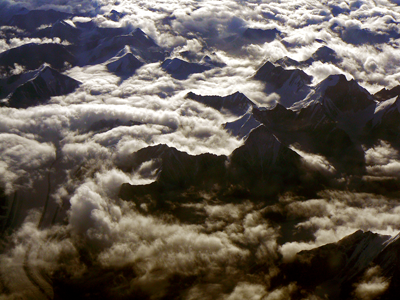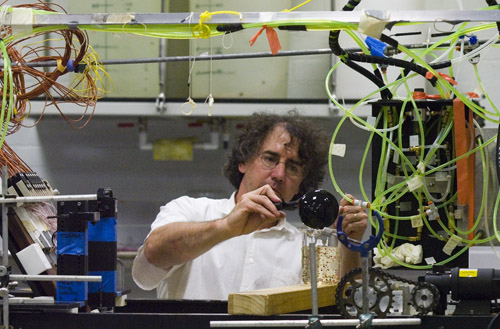2006 Annual Report
GEOPHYSICAL FLUID DYNAMICS
Earth Physics
|
 |
Geophysical Fluid Dynamics Introduction
Geophysical Fluid Dynamics is the study of fluid flows and their roles in transporting heat, mass and momentum in the oceans, atmosphere and Earth's deep interior. In RSES, the research in this field focuses on the exploration of physical processes of importance in three different areas:
• convection, mixing and circulation in the oceans, with implications for climate,
• magmatic and volcanic processes, and
• convection of the solid silicate mantle, with its implications for plate tectonics and the evolution of our planet.Geophysical Fluid Dynamics (GFD) emphasises the importance of dynamical modeling and the understanding of individual processes. At the ANU our research program is anchored strongly in experimental fluid dynamics and benefits from the excellent facilities of a purpose-built 400 sq. m laboratory and workshop area, opened in 2000. This is one of the premier GFD laboratories in the world, and one of only two such labs in Australia. It is well known for its contributions across fluid dynamics, oceanography and ‘solid earth' geophysics. A second crucial strand of our research lies in advanced computing, and this work benefits from a range of computing facilities within the Research School and in the Australian Partnership for Advanced Computing (APAC) located at ANU.
|
Figure 1 . An apparatus for the study of thermal convection being rotated on one of the rotating tables in the Geophysical Fluid Dynamics laboratory. This allows a simulation of the effects on ocean circulation of Coriolis accelerations owing to the earth's daily rotation on its axis.
SUMMARY OF DEVELOPMENTS IN 2006
Dr Hogg was appointed to a continuing position, filling the ocean modeling position advertised under the ANU initiative in marine science. The group was host to two trainees, each for 2 to 3 months during the year – Ms C. Wong from Ecole Normale Supereure des Technique Avance, Paris, and Mr J. van Jarsveld, Einhoven University of Technology. Emeritus Professor J.S. Turner continued as a Visiting Fellow. Visitors included Prof C. Kincaid (University of Rhode Island, 3 months), Prof R. Dewar (Florida State University, 3 weeks) and Prof B. Sutherland (University of Alberta, 2 weeks). Prof Griffiths, Dr Hughes and Dr Hogg taught the “Ocean Dynamics” unit in the RSES Physics of the Earth Honours program. Drs Hughes, Hogg and Kerr, and Prof Griffiths, taught a 3 rd year undergraduate course on fluid dynamics and ocean-atmosphere dynamics in the Department of Physics, ANU, and Dr Hogg contributed to first oceanography in the Department of Earth and Marine Science. The staff, students and visitors all acknowledge the vital contributions of our technical support staff, A.R. Beasley, to our research program. A trainee technical officer commenced with the group in December. A new ARC Discovery grant was awarded to Dr Kerr for laboratory modeling of lava flows.
This year, a simple model for the thermohaline overturning circulation of the oceans, that was published last year and which shows good agreement to a range of oceanic data, has been further tested through detailed comparison of the theory with laboratory experiments. The previous development of this model expressed the role of entrainment into dense sinking currents at the high latitude extremity of an ocean basin. The entrainment, a process that had previously been neglected and which cannot easily be included in general circulation models, causes substantial dilutions of the dense sinking water with surrounding waters. It can affect the global density distribution in the oceans and the rate of overturning of bottom and surface waters. The modified theory for circulation that is forced by heating and cooling at one horizontal boundary (so called “horizontal convection”) provides an excellent prediction of the density structure, thermocline thickness and rate of overturning in the laboratory experiments. Work is also continuing on the nature of the circulation when there are two sinking regions (northern and southern hemispheres) and on mechanisms by which the convective circulation adjusts to changing boundary conditions. The results are helping us to understand the oceanic consequences of global warming, including the conditions required for a possible shut-down of the ocean overturning.
Figure 2. Chris Kincaid working in the lab
Other work on ocean processes includes a study of the dynamics of the Antarctic Circumpolar Current and its response to changes in wind stress, where it was shown that the strength of the current tends to lack changes in the applied wind by two to three years. A very successful laboratory project to measure the amount of mixing that takes place in density-driven exchange flow through constrictions, such as ocean straits continued this year, along with a study of the behaviour of headland wakes in coastal waters when the flow includes eddies carried from upstream by the mean flow.
Studies of the interaction of mantle dynamics with mantle chemistry, using numerical models, have progressed to include three-dimensional simulations. A possible explanation has emerged for a strong depletion of incompatible trace elements prior to 4 billion years ago that is well-documented in ancient rocks : there was enhanced sinking of subducted basaltic crust through the early upper mantle, whose viscosity was relatively low at the time. This would make early plate tectonics more viable than previously thought and increase the expected rate of cooling early in the history of the mantle. Further, a re-examination of the heat flowing from the core into the mantle and carried away from the core-mantle boundary by mantle plumes, suggests that radioactivity is not required in the core to help drive the dynamo that generates Earth's magnetic field.
Experimental work continued on three-dimensional laboratory and numerical simulations of subduction, involving a dense high-viscosity plate simulating oceanic lithosphere, which sinks into the lower density low-viscosity reservoir simulating the mantle (figure D). The experiments reveal the influence of the lithosphere-mantle viscosity contrast on the process of subduction and the induced flows in the surrounding mantle. The experiments further reveal the influence of the subduction zone dimensions on the lateral migration velocity of subduction zone trench and slab, and the geometrical evolution of the trench and slab during progressive subduction.
Studies of model lava flow dynamics produced by the ‘run-out' of rapidly released volumes of analog fluids in pre-existing channels or valleys, in concert with theoretical solutions, showed that lava flows can be stopped by yield strength or by cooling and crust formation, depending on a number of factors such as flow volume, viscosity, yield strength and channel slope. Application of the results to a number of real lava flows has been instructive. Flows from continuous vents on a planar slope form their own channel and were examined (figure ??), again experimentally and theoretically. A novel theoretical prediction of channel width compares well with the laboratory results and field data.
Geophysical Fluid Dynamics Research highlights
| Dynamics and Chemical Evolution of the Earth's Early Mantle | Geoffrey F. Davies |
| Tectonic Evolution of the Earth | Geoffrey F. Davies |
| Thermal Evolution of the Core | Geoffrey F. Davies |
| Modelling the ocean thermohaline circulation in the laboratory | Ross W. Griffiths |
| How does the Southern Ocean respond to changes in wind forcing? | Andrew McC. Hogg |
| The Propagation and Morphology of Lava Flows | Ross C. Kerr |
| Interaction of coherent eddies with headland wake flows | Melanie J. O'Byrne |
| Mixing in ocean straits and overflows | Tjipto J. Prastowo |
| Subduction kinematics and dynamics in 3D space: Insight from laboratory and numerical modelling | W. P. Schellart |
| Three-Dimensional Flow and Temperatures in Subduction Zones | Christopher Kincaid |
